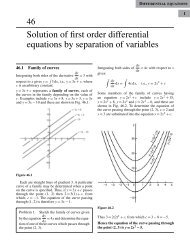vector
Create successful ePaper yourself
Turn your PDF publications into a flip-book with our unique Google optimized e-Paper software.
436 Vectors<br />
8. Evaluate F . nds ˆ. ,<br />
s<br />
and s is the region of the plane 2x + 2y + z = 6<br />
<br />
where 2<br />
F xyiˆ x ˆ j ( x z)<br />
kˆ<br />
in the first octant. (A.M.I.E.T.E., Summer 2004, Winter 2001) Ans. 27 4<br />
9. Verify Green’s Theorem for<br />
2 2<br />
( xy y ) dx x dy<br />
<br />
C <br />
where C is the boundary by y = x and y = x 2 .<br />
(AMIETE, June 2010)<br />
5.38 STOKE’S THEOREM (Relation between Line Integral and Surface Integral)<br />
(Uttarakhand, I Sem. 2008, U.P., Ist Semester, Dec. 2006)<br />
Statement. Surface integral of the component of curl F along the normal to the surface S,<br />
taken over the surface S bounded by curve C is equal to the line integral of the <strong>vector</strong> point function<br />
F taken along the closed curve C.<br />
Mathematically<br />
<br />
<br />
F . d r = curl Fnds ˆ<br />
S<br />
where ˆn = cos î + cos ĵ + cos ˆk is a unit<br />
external normal to any surface ds,<br />
Proof. Let r = xiˆ<br />
yj ˆ<br />
zkˆ<br />
dr = idx ˆ ˆj dy kdz ˆ<br />
F = Fi ˆ<br />
ˆ<br />
1 F ˆ 2 j F3 k<br />
<br />
On putting the values of F,<br />
d r in the statement of the theorem<br />
<br />
c<br />
( Fi ˆ ˆ ˆ ˆ ˆ ˆ<br />
1 F2 j Fk 3 ) ( idx j dy kdz)<br />
= <br />
i j k <br />
S<br />
<br />
x y z<br />
( Fiˆ ˆ ˆ ˆ ˆ ˆ<br />
<br />
1 F 2 j F3 k). (cos i cos j cos k)<br />
ds<br />
( F1 dx <br />
F3 F2 1 3<br />
2 1<br />
F2 dy F3<br />
dz)<br />
=<br />
ˆ F F<br />
ˆ<br />
F F<br />
<br />
i j kˆ<br />
<br />
<br />
.<br />
S<br />
<br />
<br />
y z z x x y<br />
<br />
( iˆcos ˆj cos kˆ<br />
cos )<br />
ds<br />
3 2 1 3<br />
2 1<br />
= F<br />
F F F<br />
F F<br />
<br />
cos cos cos ds<br />
S y z<br />
<br />
<br />
z x<br />
<br />
x y<br />
<br />
...(1)<br />
Let us first prove<br />
F c<br />
1 dx<br />
1 1<br />
= F<br />
F<br />
<br />
cos cos ds<br />
S<br />
<br />
<br />
<br />
z<br />
y<br />
<br />
...(2)<br />
Let the equation of the surface S be z = g (x, y). The projection of the surface on x – y plane<br />
is region R.<br />
F 1 ( x , y , z ) dx<br />
c<br />
= F 1 [ x , y , g ( x , y )] dx<br />
c<br />
<br />
= F1 ( x, y, g)<br />
dx dy [By Green’s Theorem]<br />
R y<br />
F1 F1<br />
g <br />
= dx dy<br />
R<br />
<br />
y z y<br />
<br />
...(3)<br />
The direction consines of the normal to the surface z = g(x, y) are given by<br />
cos <br />
= cos cos <br />
<br />
g<br />
g<br />
1<br />
x<br />
y










